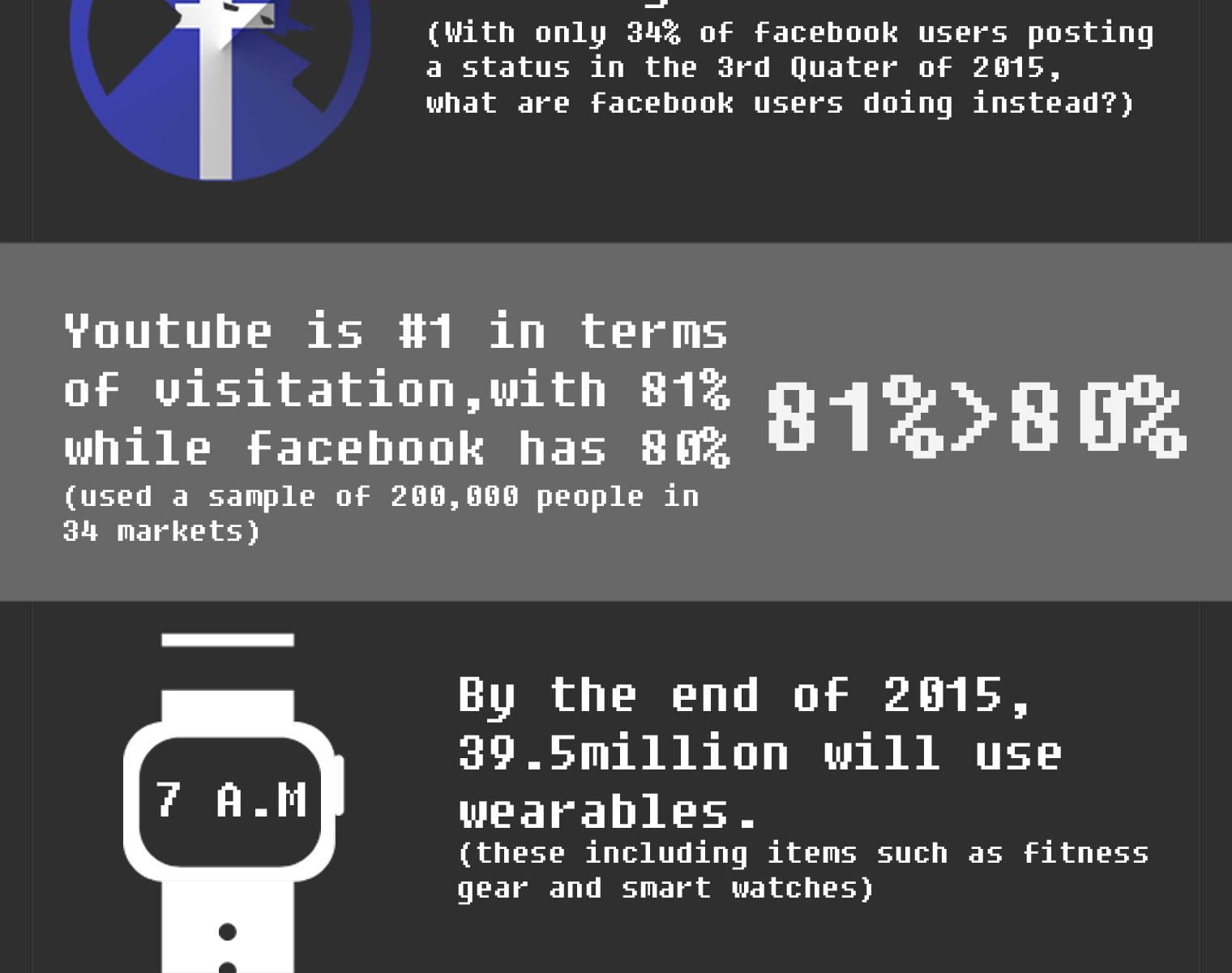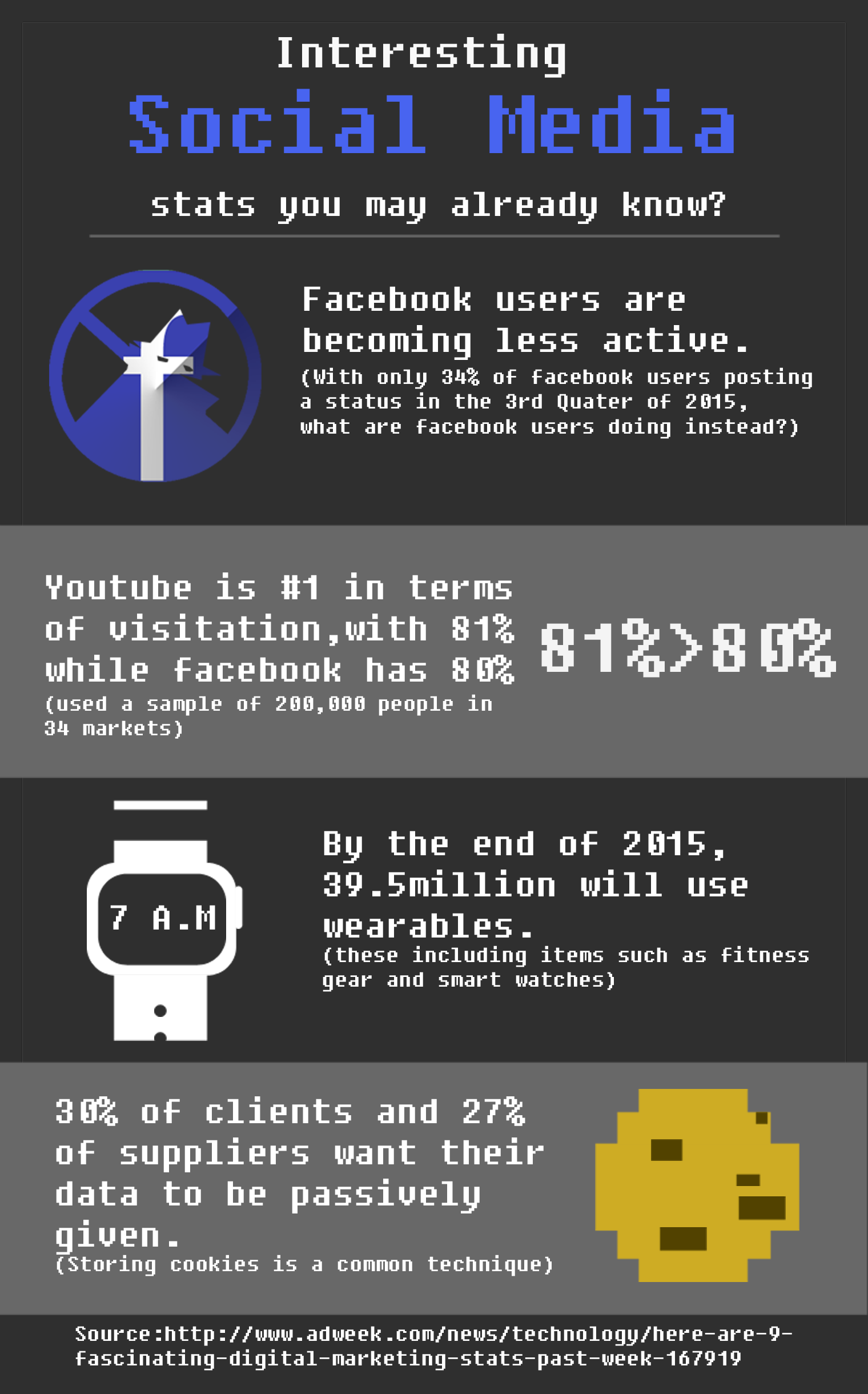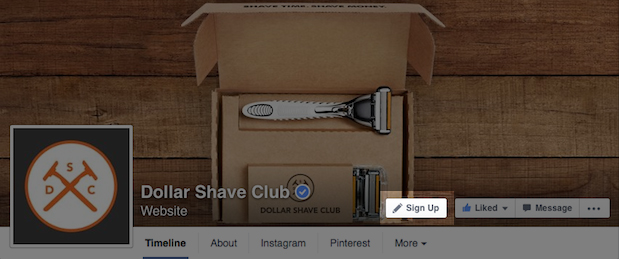By: Hayley Alexander, Nikolas Presat, Lexi Tocco, Connor Agniel, Jake Bryant
Social media is such a big part of today’s society. How a business takes advantage of social media can have a tremendous impact on their success. Social media helps attract, interact, and engage costumers to their brand. We found that 75% of consumers on Twitter never “unfollow” a brand, and 50% of consumers go online to Twitter more than once per hour. On Facebook, 49% of consumers “like” a page to support a brand. and 41% opt-in to receive updates from the brand. This shows that consumers are wanting more information from the brands they love.
Another social media outlet that is great is Instagram. 90% of the information transmitted to the brain is visual. This is why bloggers love this app; it’s quick and easy to post about your company. Instagram’s platform currently has 50 times the engagement rate over Facebook because all you have to do is scroll. Many also use YouTube as it is the world’s 3rd most popular ad network. More than 800 million visit YouTube every month, and watch more than 4 billion hours of video. So you know that people are on YouTube, so why not take advantage of it?
Lastly, businesses like to use LinkedIn as a source to promote their brand. 1 in 3 professionals on the planet are on LinkedIn, and 41% of millionaires use it. LinkedIn is all about networking and getting to know others in related fields. Who wouldn’t want to connect with a millionaire?
As you can see, all these social medial channels are great, easy and efficient, ways to promote and educate consumers about your brand.

Interesting Social Stats [Infographic]
Instagram by the Numbers

Here are 5 quick Instagram facts according to ICONOSQUARE’s Instagram 2015 Study:
Fact #1 – 61% of Instagramers like at least 1 media/day and more than 30% like over 10 media/day
Fact #2 – 64% of Instagramers are women, 36% men. 73% of Instagramers are between 15 and 35 years old
Fact #3 – 70% of Instagramers have already looked for a brand on Instagram. 41% follow or would follow a brand to benefit from special offers
Fact #4 – 48% of Instagramers are professionals. 46% of Instagramers have higher education degrees
Fact #5 – Top 3 reasons why users follow brands on Instagram: 62% because they love the brand, 54% to discover new things, 48% because they find content interesting or funny.
What is your favorite brand to follow on Instagram?
St. Louis Social Media Innovator Series: AB InBev
By: Connor Agniel, Hayley Alexander, Jake Bryant, Nikolas Presat, Lexi Tocco
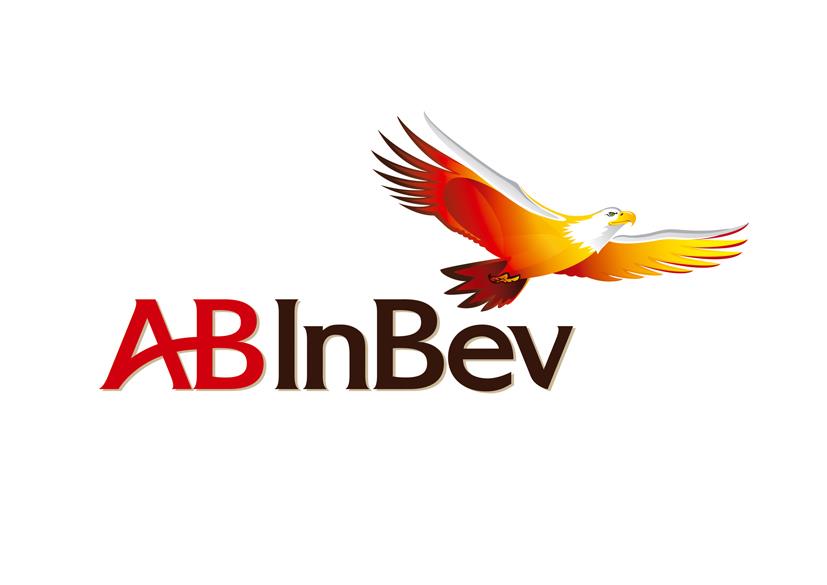
AB InBev has been working on their social media marketing for a few years. Their current focus on social media is their fans and connecting with them. Not only are they focused on growing the absolute number of fans, but they want to grow with fans who are truly engaged and interested in their company. Their social media strategy as a company is simple and straight forward; they want to connect themselves with many different fans and grow their social media accounts in order to market to their fans. This is true across all of their different brands. AB InBev wants to branch out to more social media sites such as YouTube in order to create content to help with self-distribution. This stems from their fundamental beliefs are that the consumer is the boss. If they can follow the consumer’s media behavior and entertain the consumer with their different brands and products, then they will be able to succeed as a company.
In 2013, the Ad campaign that AB InBev ran using Bud Light involving Facebook ads gained them SIX times what they spent on the campaign in returns! They found that the campaign got them a 3.3% sales lift among households that saw the ad vs. the control group that did not. “Some 22.8 million U.S. households —20% of the total — were exposed to the campaign.” This is a huge example of how proper use of Social Media marketing can play a major part in furthering a brand and its image. AB InBev is not shy to try to reach their consumers through new methods either. In 2012 they were the first company ever to do a live stream with Pandora, one of the largest music steaming websites of all. Then in 2013, they decided to do another stream with yet another music streaming giant, Spotify, all to try and really reach out to their consumer and connect.
AB InBev has realized that Social Media and digital interaction are huge parts of their consumer’s life, “…our target consumer is engaged with it 24/7/365″(Inside Anheuser…) The hardest part is figuring out the right way to engage with their consumer. To deal with this, AB InBev chooses to interact over “virtually all digital corridors and avenues and offer the consumer choice in how they would like to connect to our brands…” (Inside Anheuser…) They call this strategy “Fans First,” and have used the strategy to connect to over 30 million fans worldwide! AB InBev has different brands on all kinds of Social Media, such as Facebook, YouTube, Twitter, and more!
AB InBev has indicated that for their next moves in Social Media marketing, they want to continue to evolve as their customer does. Gaining more followers and continuing to engage with the ones that they already have.
Sources and Learn More:
Bud Light Offers Proof that Facebook Ads Work
http://mashable.com/2013/04/30/bud-light-facebook-ads/ – 20rm2CFM38qW
A-B InBev sports marketing to focus on digital engagement
http://www.bizjournals.com/stlouis/blog/2015/07/a-b-inbev-sports-marketing-to-focus-on-digital.html
Inside Anheuser-Busch’s Digital Strategy
http://digiday.com/brands/inside-anheuser-buschs-digital-strategy/
How does A-B InBev measure Facebook Success?
http://adage.com/article/digital/a-b-inbev-measure-facebook-success/244526/
Digital Marketing for Non-Profits: An Interview with Emily McNew
By Kathryn Todd
 With the 2015 State of Digital Media Marketing Conference taking place at UMSL Campus next week, we began to think about all the amazing marketing talent residing in our hometown of St. Louis. One St. Louis marketer who is blazing the way for how non-profits leverage digital and social media is Emily McNew. Emily is currently the Digital Marketing Manager at United Way of Greater St. Louis, where she is responsible for implementing the overall vision for United Way’s digital experience; including website and mobile, social media, email marketing and other digital and online marketing. In addition to her work at United Way, Emily is also the Marketing Communications Manager at STL Up Late, St. Louis’ only live late night talk show featuring the most talented and engaging guests that St. Louis has to offer. Recently we had the chance to catch up with Emily to discuss digital marketing, St. Louis, and more! Check out the full interview below: Continue reading “Digital Marketing for Non-Profits: An Interview with Emily McNew”
With the 2015 State of Digital Media Marketing Conference taking place at UMSL Campus next week, we began to think about all the amazing marketing talent residing in our hometown of St. Louis. One St. Louis marketer who is blazing the way for how non-profits leverage digital and social media is Emily McNew. Emily is currently the Digital Marketing Manager at United Way of Greater St. Louis, where she is responsible for implementing the overall vision for United Way’s digital experience; including website and mobile, social media, email marketing and other digital and online marketing. In addition to her work at United Way, Emily is also the Marketing Communications Manager at STL Up Late, St. Louis’ only live late night talk show featuring the most talented and engaging guests that St. Louis has to offer. Recently we had the chance to catch up with Emily to discuss digital marketing, St. Louis, and more! Check out the full interview below: Continue reading “Digital Marketing for Non-Profits: An Interview with Emily McNew”
Helping St. Louis Businesses Grow: An Interview with Brad Wester
 By Taylor Bartley
By Taylor Bartley
Brad Wester is a local digital marketing consultant who is passionate about helping people grow their business. You may see him at St. Louis PRSA meetings, TEDxArch events or speaking at a local event (such as the WordPress Wordcamp last week). When he is not out and about at St. Louis events, he is running his business, St. Louis Social Media Consultants. Continue reading “Helping St. Louis Businesses Grow: An Interview with Brad Wester”
Interview with the Winner of the Top Tweep Contest: Gus Gus Fun Bus
By: Kathryn Todd
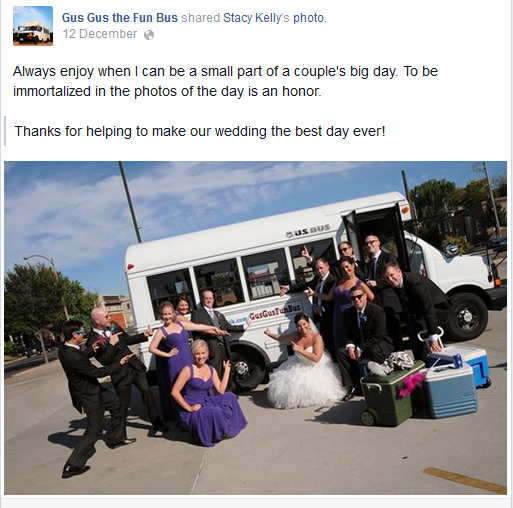 Mike Arnold is the owner of Gus Gus Fun Bus, the winner of our UMSL Digital’s Overall Top Tweep contest. The name “Gus Gus” comes from the fat mouse in Cinderella. Mike finds it fitting as the mouse is “big, awkward, not too bright.” Continue reading “Interview with the Winner of the Top Tweep Contest: Gus Gus Fun Bus”
Mike Arnold is the owner of Gus Gus Fun Bus, the winner of our UMSL Digital’s Overall Top Tweep contest. The name “Gus Gus” comes from the fat mouse in Cinderella. Mike finds it fitting as the mouse is “big, awkward, not too bright.” Continue reading “Interview with the Winner of the Top Tweep Contest: Gus Gus Fun Bus”
4 Steps to Effectively Measure Your Marketing Impact
by: Maria De Los Angeles Lopez De Lacalle, with Danni Eickenhorst
 Once a company decides to put focus on social media, one critical step they must take is determining its goals for this medium, and how it will measure those goals. The goals should be based on Key Performance Indicators (KPI), which are measurements that inform their strategic decisions in the future.
Once a company decides to put focus on social media, one critical step they must take is determining its goals for this medium, and how it will measure those goals. The goals should be based on Key Performance Indicators (KPI), which are measurements that inform their strategic decisions in the future.
1. Set the goals
We cannot determine which measurements are our KPI without first having decided our objectives. While many entrepreneurs sometimes operate without a clean business plan, most know the goals they want to achieve in order to be successful. Most business objectives have a corresponding marketing measurement.
Let’s suppose we are marketing and managing a hotel. Our objective for successful marketing would be to increase the number of sales. In order to measure how successful we are at the marketing we perform, we would need to measure and monitor the conversion rate of visitors to our website who book a hotel room.
2. Set goals and measure progress
Once we have determined the marketing measurements that best reflect our business goals, we need to establish what goals we will measure to ensure that we are making strategic decisions that achieve our business goals. We will need to establish the goals and measure our progress to make better marketing decisions.
Is very important not to measure just to measure. It does not worth it know my conversion rate if I don’t compare it with my goal.
3. Analyze the data
Once we have our measurements and goals, we must measure and analyze. While measuring our progress is important, it cannot be truly useful without further analysis. Some things we might consider include:
- How did those who visited our website and booked a hotel room arrive at our site?
- Of all of the sources of traffic, which ones were most likely to convert into booked rooms?
- Do we have any benchmark data we should compare against? What’s changed? Is it a positive or negative change?
- Do we have competitor data to compare our data to? While not all competitor metrics are comparable, since we have reduced access to their data, there is almost always something you can find through social networks or online research to benchmark your successes against those of your competitors.
4. Interpreting & Representation of data
With all the indicators collected, measured and contextualized, you have now arrived at the moment to represent that data. Consider the audience who will be reviewing your data.
If your audience is executives in a board room (professionals who don’t specialize in marketing, but who are more concerned with bottom line business goals), you may wish to display and convey this data in a way that avoids marketing jargon and showcases your actual impact on the bottom line. One way you may present this data is, “We launched a campaign to drive our Facebook and Twitter followers to our website in February. In February, we received 5,000 new website visitors from these channels, which was 75% higher than previous months. We analyzed the data, and in the end, found that Facebook visitors were 33% more likely to convert to sales once they arrived on our site. We plan to repeat and analyze this approach and data going forward, but preliminarily feel that our efforts might be best adjusted going forward by spending a proportionally higher amount of our marketing time and dollars on Facebook over Twitter.”
If your audience is a group of marketing professionals, you may wish to pair this data with more technical marketing measurements, such as engagement, followers, time on site, etc.
If you choose to utilize graphic representations of your data, carefully consider whether graphics or charts will be better received by your audience. Always tailor the information delivered to that audience.
In the interpretation of your data, results and insights in this way, with analysis and strategic direction recommendations, you are providing value, and helping your company make stronger strategic decisions.
Brand New Addition to Facebook Pages: Calls to Action
For the holidays, Facebook launched a new call-to-action feature that will help Pages drive business objectives. Continue reading “Brand New Addition to Facebook Pages: Calls to Action”
#TopTweeps: St. Louis' Top Twitter Influencers Announced
And the winners are…
UMSL Digital Mindshare was looking for a short list of the best Tweeps in the St. Louis region and a short list of the greatest minds, sharing their wisdom in 140 characters or less. Maybe you’ve seen one or more passing by on Twitter.
The UMSL Digital Mindshare #TopTweeps contest kicked off 11/6 and wrapped up 11/26. All Twitter votes were counted by our UMSL #TopTweeps jury. Special thanks to those who voted and our compliments to the nominated! You all did an excellent job and we couldn’t have done it without you!
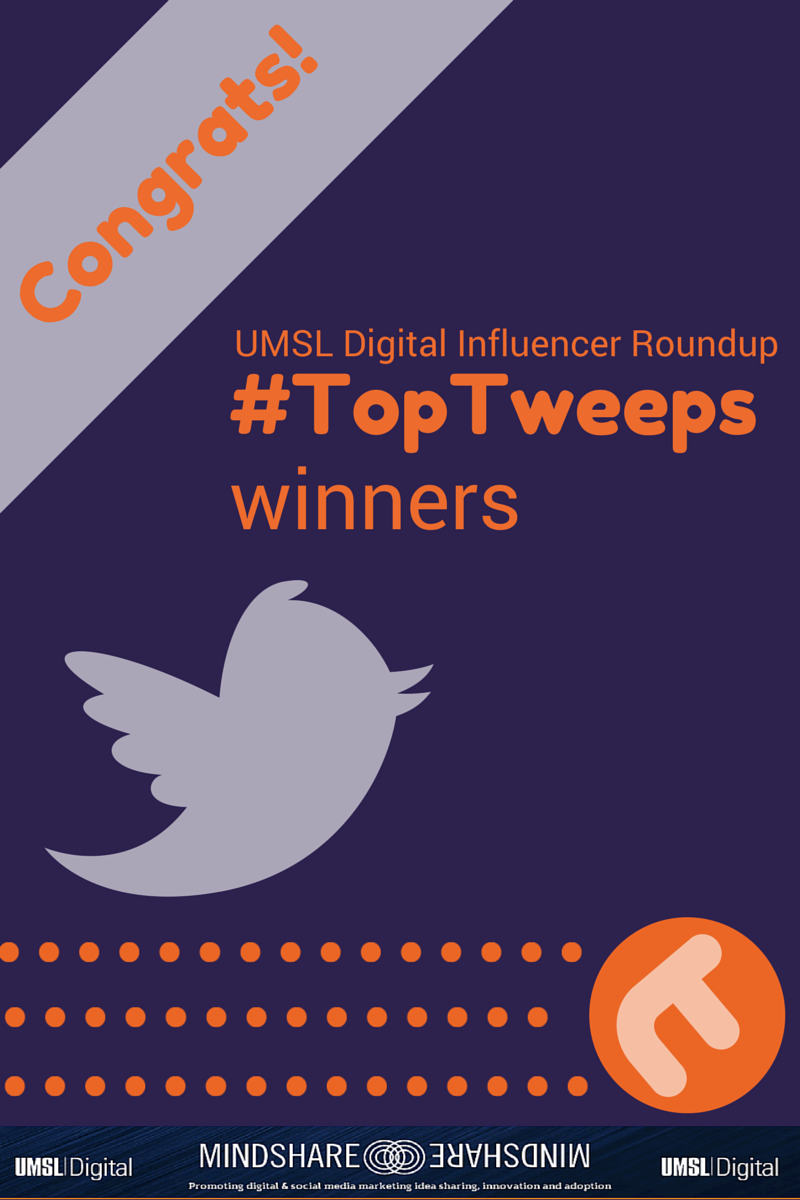 Now after all the energy, sweating and tweets, we are proud to announce the winners.
Now after all the energy, sweating and tweets, we are proud to announce the winners.
Best of Art & Entertainment
@theLunaLounge
Best Local Brand
@stlwinegirl
Best Business Leader
@cat_neville
Best Advocate
@MayorSlay
Best of Sportsball
@StLouisBlues
Best of Fundraising
@steveshotdogs
All Around Best Tweep
@GusGusFunBus

